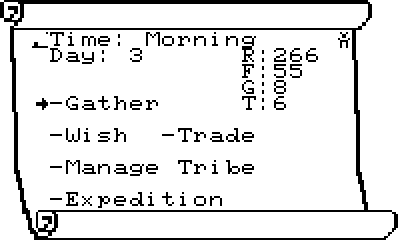Goblin Village
I would have played so much Goblin Village on my TI-83 graphing calculator in middle school (complimentary). It’s a mostly text-based roguelike where runs last around 2-10 minutes, and for some reason it conjures up memories of an Oregon Trail-esque edutainment DOS game from my youth called The Lost Tribe. I don’t expect anyone to have played that, but it’s funny how memories work and what they hold on to.
In Goblin Village, you choose a tribe leader and try to help your goblin crew survive as long as you can. This means juggling resources (which are taxed an increasing amount every in-game day), food (each member of the tribe needs to eat), and the actual number of goblins in your tribe (more goblins means that they’ll forage more food and resources with each action, but they also cost more food to feed). You can also send two goblins on a four-day expedition, one at a time, to bring back a huge amount of resources, food, or trinkets (choose one). Run out of food or be unable to pay the taxes on your resources and it’s game over. Use your acquired trinkets to buy some permanent buffs in between runs and then get back out there.
Each day, you have three and only three actions. Forage for food or resources? That’s one. Send goblins on an expedition? That’s one. Recruit/fire a random number of goblins? Make a wish, which is a gamble that you’ll often lose but winning gets you a ton more resources/food than you can get just by foraging? Either of those cost one action, too. The game balance between having enough goblins to forage enough resources while also being able to feed them all is perfect. Even if you feel like you’re doing well, once the taxes really start to go up later in a run, it can all fall apart quickly.
There are a ton of goblin leaders to collect, each with a different boost. Each is unlocked in a certain way, so you’ll have to use leaders that aren’t too good sometimes to unlock the better ones – it’s not always just about seeing how long your run can go. There’s also a story mode where you’ll unlock each subsequent chapter by performing certain tasks, like “go on 10 expeditions” or “collect 5,000 food.” It’s a cute little tale written by the developer’s dad, but it’s presented in a wall-of-text format that’s a bit hard to read. Needs a bit more spacing/line breaks to make it easier to digest! The content is nice, though; it’s like a bedtime story you could read to your kid.
There are random end-of-day events (and the occasional mid-day events) that either increase or decrease one of your stockpiles. There are apparently over 1,000 of these, and that’s a lot! But there are some typos in them sometimes, and I was chalking this up to just enthusiasm and over-reaching during development. But the errors are actually because of the AI used to help create them. Let’s talk about that a little bit.
The Playdate Catalog website doesn’t have a way to explain yourself in this area. For Goblin Village, it contains the disclaimer, “The developer used generative AI to create game code, game sound, and text or dialog.” Which really makes it sound like basically the whole thing was a product of the rainforest-burning plagiarism machine that is generative AI. If you’ve ever seen any of the “games” that are fully made with AI, however, you’ll know that something like Goblin Village, made without a guiding hand, would not be possible. Because AI – especially in the myriad ways it’s currently being shoehorned into seemingly every once-usable software product in the world – is stupid.
I asked the dev about this, and he explains more fully on his Itch page:
”I had AI help me write one song, the rest were originals and from a paid musician. Some of the end of day events were written with AI. AI was also used to track down several bugs I couldn't figure out on my own. Everything else, including all art, sound effects, and every story component are original with no AI involvement.”
If 97% of the game is a product of your own blood, sweat, and tears, why tarnish it at the finish line? Pay the musician a little more to write one last song (or just re-use one from another part of the game, or do it yourself in the Pulp editor, or even just have silence). Write 25 handcrafted end-of-day events that might repeat more often instead of generating 1,000 that don’t mean anything. And as for bugs: the Playdate has a huge, helpful developer community that would’ve loved to help you track them down and squash them. GenAI is costing jobs, uses more energy than entire countries, and gives answers that make people SO SURE of something which is patently wrong. Every time a Playdate game uses it, even in small amounts, it’s a mark against it. Foie gras could be the most delicious food in the world, but I know how it’s made so I don’t want to eat it, especially when I can make an Impossible meat patty melt myself that’s good enough to be served in restaurants.
Maybe you don’t have any issues with GenAI. And the game itself is a great little time with a good sense of progression. You’ll definitely feel a lot better after ten minutes with it than spent doomscrolling on social media. But when something clearly made with heart is marred by the soul of a machine, it’s hard to be completely on board.
(Released July 8, 2025, on Catalog and Itch. Copy provided by developer.)
